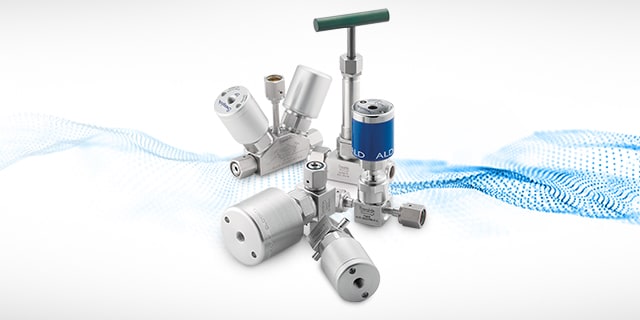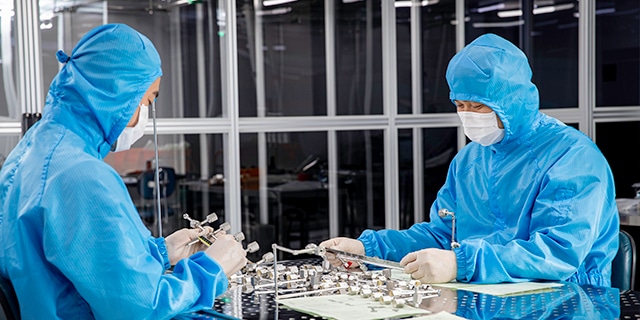High-Purity Face Seal Fittings Explained

Why Vacuum Face Seal Fittings are Ideal for High Purity Semiconductor Applications
Masroor Malik, Semiconductor Market Manager, Swagelok
Given the semiconductor industry’s never-ending pursuit of the smaller and smaller process nodes necessary to produce more powerful chips, maintaining process cleanliness is more and more challenging. To meet these ever-changing needs, fabs must create production environments of uncompromising precision and cleanliness, and OEMs must develop equipment that continually rises to meet those needs.
In the most demanding ultrahigh-purity (UHP) fluid system applications—inert or specialty gases, for example—fitting connections are a critical consideration for tool OEMs. Though UHP systems are often welded to minimize the possibility of leakage, certain connections must be periodically remade for maintenance or replacement. But due to the corrosive nature of some modern process fluids and operating conditions, traditional fitting options with elastomer O-ring seals may be unsuitable for reliable service due to material incompatibility. Meanwhile, leak-tightness is of utmost importance. Leaks can be hazardous, may contaminate the UHP environment, and can cost the manufacturer significantly in lost revenue and maintenance expenses.
In these applications, vacuum face seal fittings can represent a potential solution. Compared with traditional fittings, this technology provides the reliability of a metal-to-metal seal, offering leak-tight performance with a vacuum-to-positive-pressure design. Vacuum face seal fittings can also help enhance overall cleanliness by minimizing entrapment areas and can improve production and maintenance efficiency with their simple installation process.
 Uncompromising Seal Performance
Uncompromising Seal Performance
Vacuum face seal fittings were first developed for use in ultra-high vacuum systems in the 1960s, which were pivotal to groundbreaking scientific research for the nuclear energy industry. Today, their ability to maintain a leak-tight seal for highly toxic, corrosive, and flammable fluids has made them ideal for some of the most popular applications in semiconductor production.
A vacuum face seal fitting uses two highly polished beads to deform a metal gasket during the engagement of the male and female nut to achieve such high levels of performance. The seal occurs on the gasket at the bead “face,” granting the fitting its name. Because the seal is formed when the beads penetrate the gasket, gasket material must always be softer than the beads. This deformation allows the beads to retain their polish, which is critical to seal performance. Importantly, the polished beads should be protected whenever the fittings are disassembled. Under regular operating conditions, the seal is fully swept by the gas flowing through the fitting, making it easy to purge and ideal for systems where trapped volumes and dead space must be avoided.
Vacuum face seal fittings’ ability to maintain a leak-tight seal has made them ideal for some of the most important applications in semiconductor production.
In addition to creating a reliable seal, vacuum face seal fittings are designed to eliminate areas for potential contaminant entrapment when compared to traditional tube fittings. Because semiconductor UHP processes contain gases that will ultimately travel downstream and be exposed to the wafer in the process chamber, any opportunity to ensure cleanliness and purity is valuable. Vacuum face seal fittings offer the kind of outstanding cleanliness that semiconductor production environments demand. Some suppliers may offer additional enhancements; higher grade stainless steels with elevated nickel and chromium concentrations can further improve corrosion resistance, and surface finish treatments like electropolishing leave a passivation layer for enhanced cleanliness.
Efficient Installation and Maintenance
Maintenance and upkeep procedures for UHP systems must be completed quickly and with minimum disruption to facility operation, because in the world of semiconductor fabrication, time is money.
Since they can be easily disassembled and remade, vacuum face seal fittings offer efficiency and maintenance benefits in UHP applications where a make-or-break point is required. Installation is simple and can be performed with common tools. First, the connection is screwed together until finger tight. Then, the male nut is held steady while the female nut is advanced 1/8 turn (45°) past finger-tight with a wrench (or 1/4 turn 90° if using a copper gasket). When remaking is required, technicians need to remove the used gasket and replace it with another, then follow original makeup instructions. This simple process can create efficiency during initial system assembly and whenever maintenance is required, helping users get back into production more quickly.
Watch How to Install a Vacuum Face Seal Fitting
Vacuum face seal fittings represent an ideal choice in UHP systems where reliability and ease of maintenance are critical. If you decide to specify them for your system, it is also important to work with the right supplier.
Swagelok has a heritage of innovation in fluid systems for semiconductor application processes that goes back to the early days of Silicon Valley. Our VCR® metal gasket face seal fittings were designed specifically to solve the unique challenges encountered in the handling and distribution of UHP gases that flow through fabricator facilities to OEM chip manufacturing tools.
We understand the everyday challenges faced in a semiconductor production environment—and we are happy to share our knowledge with our customers. We offer comprehensive training courses on our VCR fittings, their design features, and where they can be most effectively deployed. Participants can also learn what it takes to install each fitting type effectively and how to troubleshoot any potential issues.
Interested in learning more about how our VCR face seal solutions and training opportunities? Our specialists are ready to help.
Related Articles

How to Solve Top ALD and ALE Semiconductor Processing Challenges
ALD and ALE semiconductor production processes come with some inherent challenges and complexities. Learn how the right selection of process valves can help you overcome them.

Improve Semiconductor Yield with Optimized Alloys
Discover how semiconductor fabricators can improve end-to-end production yields and improve long-term profitability by selecting the right metals for critical fluid system components.

Innovation for the Next Generation of Semiconductor Manufacturing
The next generation of advanced semiconductor manufacturing presents a host of unique considerations. Read how manufacturing innovation can be achieved through greater capacity utilization, component reliability, and process control.

